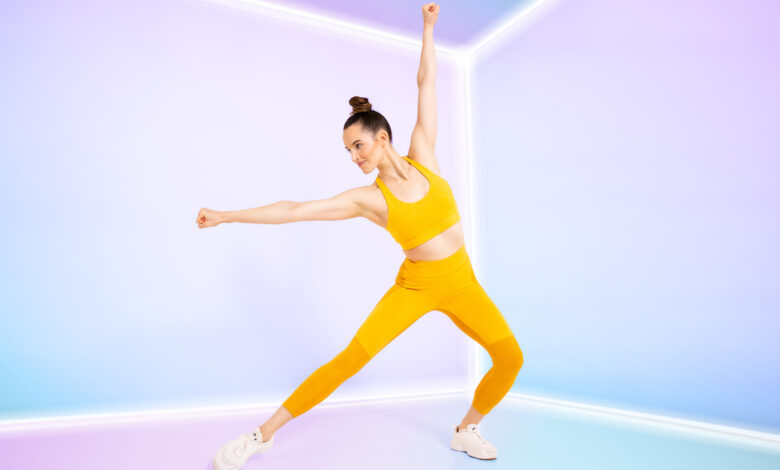Obé Launches Personalized Training Plans

Obé users can take a quiz about their fitness objectives, time availability, and class type preferences, and they have the option to sync data from Apple HealthKit to the Obé app. Based on this info, Obé will recommend bespoke progressive training programs, meant to increase in challenge over time.
“It’s very prescriptive day by day, telling you exactly what to do to make the most of your time that you’re using to work out and also to prevent ‘the scroll’ of looking for the right class to take,” co-founder and co-CEO Ashley Mills says. “But it’s also flexible and adaptive based on [a user’s] unique physiology and what else she has going on in life.”
A wealth of fitness programs using technology to offer personalized options—from one-on-one training to quiz-based recommended plans—have emerged in recent years. It makes sense that Obé would choose to compete in this sphere, offering its own flavor of personalization.

When the pandemic happened just two years after launch, Obé was one of few fitness brands that already had streaming and online content operations up and running, which led to a “hyperbolic rush of new eyeballs,” says co-founder and co-CEO Mark Mullett.
Today, Mills says the Obé community is as robust as ever, in terms of subscribers and viewership. But now, over three years since the start of the pandemic and after the end of the COVID-19 public health emergency, what people are looking for in a virtual fitness platform has evolved.
“So many people were trying digital fitness for the first time, and that exploratory phase was really awesome,” Mills says. “Now what we’re seeing coming out of the pandemic and this shift three years later is that our audience, as well as the audience that we are trying to market to, they’re really looking for a much more prescriptive program that is personalized for them.”
Obé conducted surveys of existing users, as well as target market users, and found that people’s lives have become less flexible than they were during the work-and-work-out-from-home era. They still want to exercise (and get stronger, specifically), but they have less mental energy for it. So figuring out what class to do from an endlessly scrollable content library is a major hurdle.
But as great as opening an app and getting served your exercise for the day can be, Obé is also aware that someone’s energy, recovery status, or just other things they have going on in their lives, can make a single scheduled class not always the right fit. So Obé will serve a few options for classes, alternating between days of strength, cardio, and recovery. It will also let you log exercise that you do outside of the Obé universe in the platform and store it in your user history, so you’re able to see a full picture of your fitness.
“I think we can all agree that things come up that get in the way of the fitness plan,” Mills says. “Let’s say you have a HIIT class that you’re supposed to be doing on that day, but instead you go for a run or you go for a walk with a friend; that should be considered your cardio. So we’re making sure that we can track all of that to give [a user] a really well-rounded understanding of what her fitness life is and what she needs to do for optimal health.”
Obé says it will also integrate data from wearables into your program, but it’s not yet clear exactly how that will work. One example Obé gives is cycle syncing, and recommending a certain intensity of classes based on where a user is in their menstrual cycle. Menstrual cycle syncing is all the rage right now, even though experts say the science is not quite there yet. Still, being aware of how energy levels can differ may help someone tap into the needs of their body.
Another way Obé will use wearables data is as a signal that it’s time to increase the difficulty level and move a user into, say, intermediate progressive phases, says Mills. (The plans are designed in month-long chunks, and the user can see two weeks at a time.)
Obé had already launched a few progressive strength training programs, and will be using those as part of the content for the series, as well as repurposing other content. But it will also shoot new videos with the progressive ends in mind.
So, do class suggestions of new and existing content really count as personalization?
“Out of the gate, it will never be as personalized as the end goal, and the vision for it,” Mills says. “When you’re building a technology product like this, they are very much iterative and you add in features as you go to make those recommendations even better.”
Users will also still be able to use the app as they always have if they don’t want to take advantage of the new quiz-based programs. At its heart, Mullett says the goal of the platform has not changed—just the delivery.
“One of our initial theories on the business was, how can you help people get fit and get healthy, but not bored and not dread [exercise]?” Mullett says. “We’ll still give you that same variety, that same library of express classes and everything in between. We’re just trying to make it that much easier. But we’ll never lose the fun factor. We’ll never lose the mission around efficacy. We’ll never lose the mission around community, but we’ll just keep evolving.”
Our editors independently select these products. Making a purchase through our links may earn Well+Good a commission.

